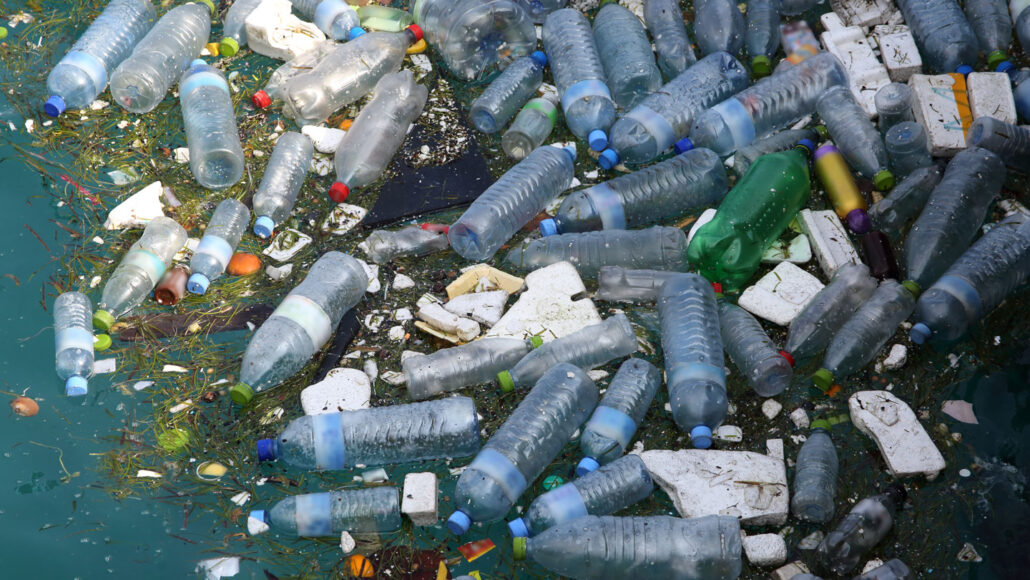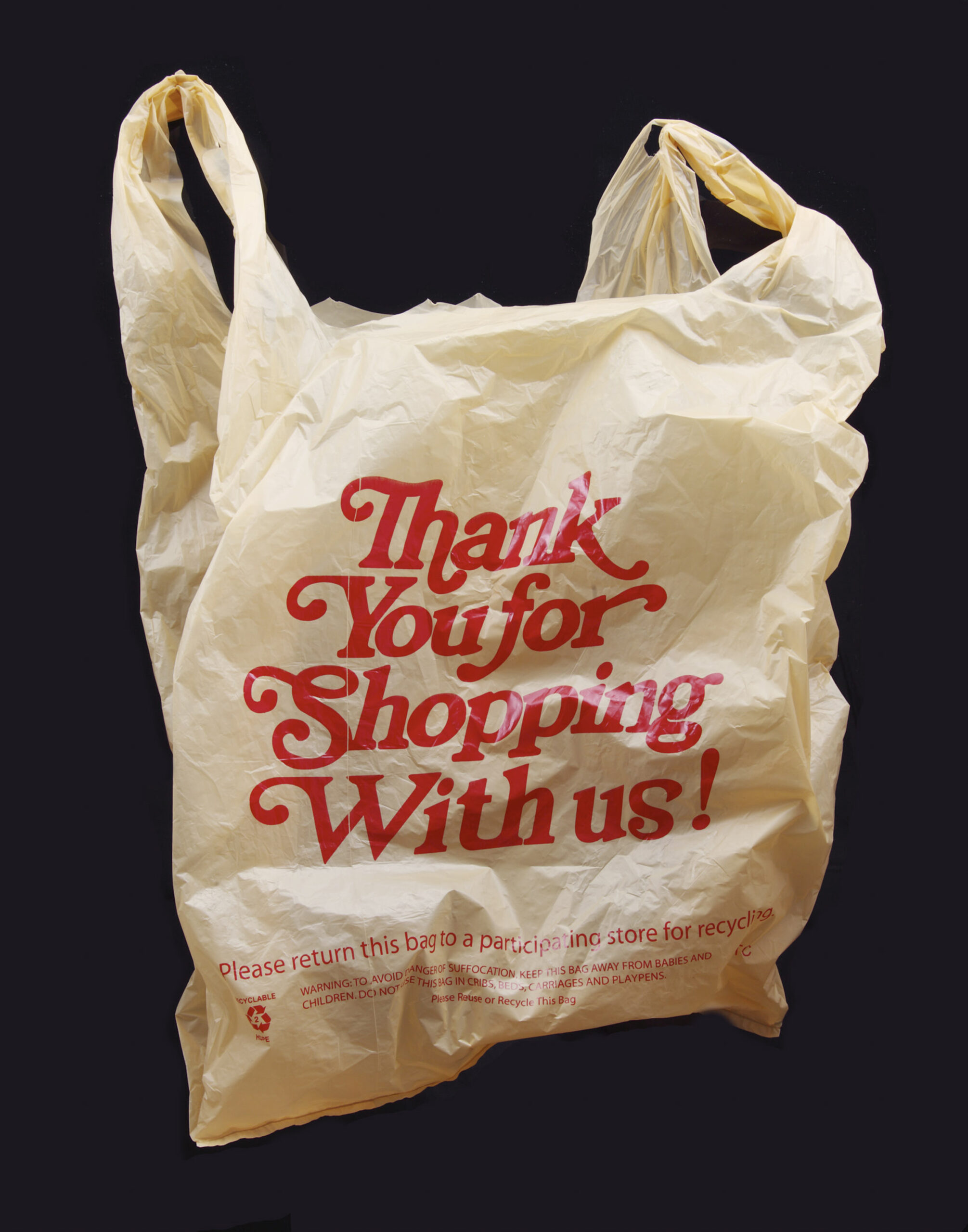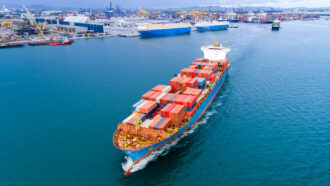Everyday plastics can pollute, leaching thousands of chemicals
Their pollutants, some of which may be toxic, can enter food and water, new data show

These plastic containers leached chemicals — both into the water they once held and into the harbor where this trash has ended up. That’s the conclusion of a pair of new studies.
Rosemary Calver/Stone/Getty Images Plus
Bits of plastic litter the world. It’s become a big and growing problem from the depths of the ocean to Arctic glaciers and even European mountain peaks. Much research has lately focused on how plastic products in the environment break down into smaller pieces and where those bits wind up. But two new studies find it’s not just the plastic pieces that pose a problem. Intact plastics can release pollution — tens of thousands of chemicals. And those pollutants likely end up in water and food, those studies now conclude.
Many of these chemicals come from additives. Such additives include pigments, fire retardants and more. They make plastics stronger, more colorful or better in some way. But those additives are not chemically bonded to the plastic. That means they can move out and into the environment through a process known as leaching.
Most studies of plastic pollution have focused on pure plastic. These are types to which additives have not yet been added. Both of the new studies used plastic bags and containers as we use them, complete with additives. And through normal use, these plastics can release other chemicals as pollutants, the studies now report.
“We do not know whether there are health consequences from the plastic chemicals [pollutants] we looked at,” says Martin Wagner, one of the authors. Still, he argues, people should be concerned. “They are being sold products they use every day without knowing whether the chemicals they are exposed to are safe.”

Educators and Parents, Sign Up for The Cheat Sheet
Weekly updates to help you use Science News Explores in the learning environment
Thank you for signing up!
There was a problem signing you up.
Unsafe to eat?
Wagner is a biologist at Norwegian University of Science and Technology in Trondheim. He recently teamed up with Lisa Zimmermann at Goethe University Frankfurt am Main in Germany. She’s an ecotoxicologist. That means she studies how chemicals may poison organisms in the environment. Together, they became part of a team that studied whether pollutants can leach from plastics into food.
They looked at everyday food containers. These included different types of plastic bags, bottles, fruit trays, coffee cup lids, gummi-candy packaging, shower shoes and yogurt cups. In all, these included eight different types of plastic. Each used different additives. The team extracted chemicals from each plastic sample. They also put a piece of each sample into water and kept it in the dark at 40° Celsius (104° Fahrenheit) for 10 days. Afterward, they tested the water for signs of any leaching of chemicals from these plastics.
They also tested the extracted chemicals and those that leached from water in toxicity tests. For instance, they looked at whether the chemicals could sicken cells. They also tested whether the chemicals might mimic or block hormones. And they used a device known as a mass spectrometer (Spek-TRAH-meh-tur) to identify the total number of different chemicals released by the plastics.
Chemicals leaching into water were toxic at concentrations we might encounter under normal use, they found. And every type of plastic leached at least some toxic chemicals. Only a few of the plastics leached chemicals that mimic or interfere with the body’s hormones. In total, some plastics leached a few hundred chemicals. Others, they found, leached tens of thousands.
The team shared its findings September 7 in Environmental Science & Technology.
Shining some light on the subject
When plastic bags and products are discarded, they can end up as litter. Massive amounts of trashed plastic wind up in our oceans. For many years, researchers thought sunlight would simply crack or otherwise break down the trash into smaller bits of the original plastic. Anna Walsh wondered if sunlight might also cause plastics to leach pollutants into the water. An environmental scientist, she works at Woods Hole Oceanographic Institution. It’s in Woods Hole, Mass. There, she’s part of a team that studies ocean chemistry.

Her group analyzed pieces of common plastic bags. These were made from polyethylene (Pah-lee-ETH-ul-een), a plastic commonly found littering the ocean. They cut pieces and placed them in beakers of seawater. Some were left in the dark for six days at room temperature. Others were placed for five days under lights that included all the wavelengths in sunlight. These were chilled to keep the water at the same temperature as the dark samples.
Plastics leached twice as much pollution in sunlight as in darkness, they found. One bag leached 263 different chemicals in the dark but more than 13,000 when exposed to light! Others leached even more. And the longer bags were exposed to sunlight, the more chemicals they leached. “Sunlight can lead to these transformations relatively quickly,” Walsh says. In weeks to a few months, they can leach “tens of thousands of different chemicals.”
Her team shared its findings September 21 in Environmental Science & Technology.
What that means for ocean health is still unknown, Walsh says. But scientists are working on it. “We’re making great strides towards understanding how the many different plastic types in the ocean break down, how long they last and their effects,” she says.
Chemists had long thought plastic would last forever in the environment. But the truth is much more complicated. “Plastics are extremely tough materials,” Walsh admits. “But sunlight has the power to break them into all of these chemicals that we saw in the study.”
Risks remain a mystery
“It is good to see that more and more studies use realistic circumstances for their exposure experiments,” says Susanne Kühn. She is a marine biologist at Wageningen Marine Research in the Netherlands. It’s troubling, she says, that people “are exposed to substances where we do not know how toxic they may be.”
What’s more, she adds, there’s no government regulations to ensure these chemicals are used safely. The Zimmermann study “support[s] the growing body of evidence that plastics can be harmful, not only when ingested directly but also when in contact with human food,” Kühn says.
The good news is that we “can reduce exposures to these chemicals by reducing the use of plastics,” says Wagner in Norway. He suggests eating less food that comes in plastic packaging. “This will not only be good for us,” he argues, “but also for the environment.”







